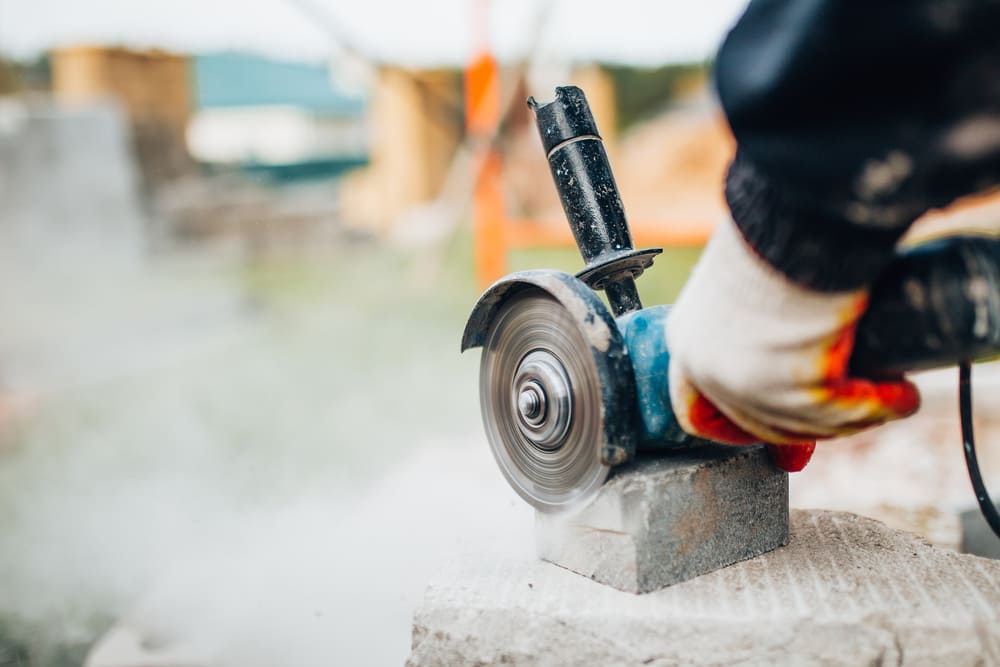You might be very familiar with Devour Tools blades as angle grinder blades. We have diamond blades for tile, metal, and even concrete. We routinely remind customers to use the right tool for the job. When it comes to concrete, the top three options are masonry, cut-off, and concrete saws. For smaller jobs, you will want to use a grinder or even a circular saw.
Each type of saw has its own applications. There is some overlap, but not much. So before you install one of our diamond blades and prepare to cut, make sure you know your tools. Make sure you are using the right saw for that particular application.
The Masonry Saw
The masonry saw looks a lot like a typical table/miter saw used to cut wood. But as its name implies, its most common application is cutting through things like masonry bricks and small blocks of concrete. There are also different sizes of masonry saws. Those on the smaller side are more applicable to brick while the larger saws are generally reserved for larger blocks.
A masonry saw can typically be used either wet or dry. Likewise, Devour Tools diamond blades can be utilized under either scenario. When dry cutting though, extra caution is warranted thanks to dust, flying debris, and excess heat.
Using a masonry saw is pretty straightforward. You mark a guide line on your brick or block, place the material into the built-in tray, lower the blade and work the material into the blade. Depending on the depth of the material, you may have to make more than one pass.
The Cut-Off Saw
A cut-off saw is a rather large, but lightweight hand-held saw that can cut through a variety of materials. It takes a lot of skill and a steady arm to operate one of the saws effectively. In the hands of a skilled worker though, a cut-off saw can make quick work of concrete.
Cut-off saws come in a variety of sizes and speeds for different applications, and they can be powered by electricity or gas. As for wet and dry cutting, most are capable of both. The cheaper cut-off saws may not come with a built-in wet cutting system, but you can probably add aftermarket parts to take care of that.
The key to using the cut-off saw effectively is to take your time. Because this is a hand-held saw, you are applying the blade to the material rather than the other way around. Therefore, a slow and consistent approach is best.
The Concrete Saw
Known more formally as the walk-behind floor saw, the concrete saw is essentially a heavy-duty saw mounted on a frame with wheels. Its upright design makes this saw ideal for cutting into concrete and asphalt surfaces. You see road crews using walk-behind concrete saws all the time.
A typical concrete saw has a blade ranging from 18 to 20 inches. Saws capable of accommodating smaller blades can make cutting green concrete a bit easier. But again, a slow and consistent approach is best. You are still driving the blade through the material instead of working the material into the blade.
For smaller jobs
For the smaller jobs you can use an angle grinder or even a circular saw. These tools can be used with blades sizes from 4.0” up to 7.0”; and make concrete cuts from ½” deep to 1 ½ “ deep. Be sure you are pairing the right tool with the right blade. A 4.0” grinder should be used with a 4.0” blade, etc. Circular saws will commonly be used with a 6.0” or 7.0” blade. You can also cut wet or dry with these tools. Likewise, Devour Tools diamond blades can be utilized under either scenario. When dry cutting though, extra caution is warranted thanks to dust, flying debris, and excess heat.
In all cases, it is important to let the blade do the work. A diamond blade is capable of cutting the hardest materials in the world. It really doesn’t need your help. As the operator of the saw or angle grinder, you are more or less a guide.
As always, you can count on Devour Tools diamond blades to get the job done. We have a blade for nearly every application. If you ever have questions about our blades, do not be afraid to ask.



